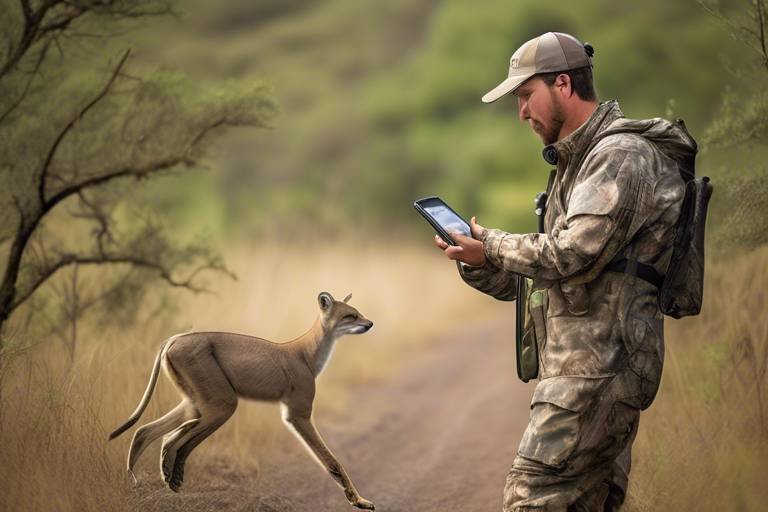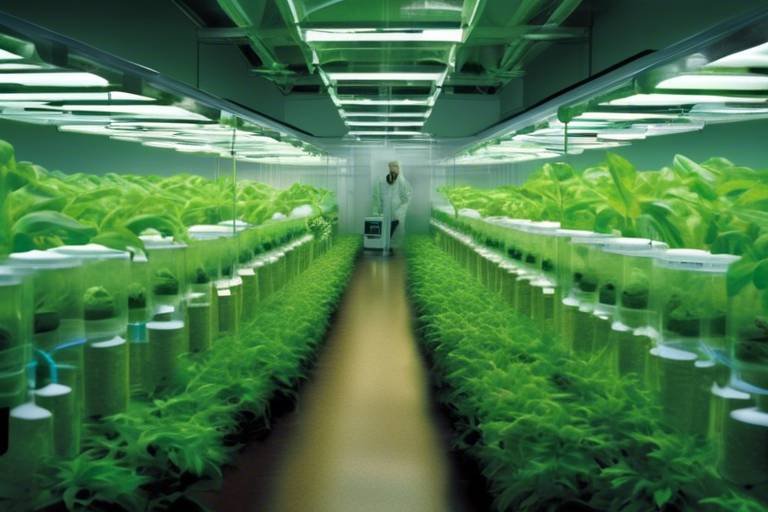Future Trends in Wildlife Tracking Technologies
The realm of wildlife tracking is rapidly evolving, driven by groundbreaking technologies that are reshaping how we understand and interact with the natural world. As conservationists and researchers strive to protect endangered species and their habitats, innovative tools and methodologies emerge to enhance our tracking capabilities. Imagine being able to follow the migratory journey of a monarch butterfly or monitor the daily activities of a rare bird species in real-time. This is not just a dream; it is becoming a reality thanks to advancements in GPS, satellite technology, and data analytics.
In today’s world, where biodiversity faces unprecedented threats, the integration of technology into wildlife tracking has never been more critical. The future trends in this field not only promise to improve the accuracy of data collection but also aim to revolutionize the way we approach conservation efforts. From understanding animal behavior to monitoring their habitats, these technologies are paving the way for a more informed and proactive approach to wildlife conservation.
As we delve deeper into the future trends of wildlife tracking technologies, we will explore how these innovations are enhancing our ability to gather precise data, the implications of miniaturization for small species research, and how data analytics and remote sensing technologies are changing the game. With these advancements, we are not just observers of wildlife; we are becoming active participants in their conservation.
Recent developments in GPS technology have significantly improved the accuracy and efficiency of wildlife tracking. Researchers can now gather precise data on animal movements and habitats, which is crucial for effective conservation efforts. For instance, GPS collars and tags provide real-time location updates, allowing scientists to track the migration patterns of large mammals like elephants and whales with unprecedented detail.
This technological leap enables researchers to answer critical questions about wildlife behavior. Where do animals go during different seasons? What routes do they take when migrating? Understanding these patterns is essential for creating effective conservation strategies. Moreover, advancements in battery life and signal strength mean that these devices can operate for longer periods without needing maintenance, allowing for continuous monitoring over extended timeframes.
Satellite tracking has revolutionized wildlife monitoring by allowing real-time data collection over vast distances. This technology provides critical insights into migratory patterns and habitat use, enhancing our understanding of animal behavior. Imagine tracking a sea turtle as it journeys across oceans or following the flight path of migratory birds as they traverse continents. Satellite tracking makes this possible, offering a comprehensive view of animal movements.
The miniaturization of tracking devices has been a game-changer in wildlife research. Smaller devices can now be attached to species that were previously too small to monitor effectively, such as tiny birds or small mammals. This advancement opens new avenues for research, allowing scientists to gather data on a broader range of species, which is crucial for understanding biodiversity.
With smaller tracking devices, researchers can now monitor the movements of small mammals and birds, providing valuable data that was previously unattainable. For example, tracking the behavior of a small songbird can reveal important information about its habitat preferences and feeding habits, which can inform conservation strategies tailored to protect these species.
However, deploying miniaturized devices comes with its own set of challenges. Researchers must ensure that these devices are durable and functional without compromising the animal's well-being. Balancing technological innovation with ethical considerations is paramount in wildlife tracking, as the goal is to gather data without causing undue stress or harm to the animals being studied.
The integration of data analytics and machine learning into wildlife tracking is transforming how we analyze large datasets. By uncovering patterns and trends, these technologies help inform conservation strategies and improve our understanding of species behavior. For instance, machine learning algorithms can process vast amounts of location data, identifying migration routes and habitat usage patterns that were previously hidden.
Remote sensing technologies, such as drones and satellite imagery, provide comprehensive views of ecosystems. These tools help researchers monitor wildlife populations and their habitats while minimizing human disturbance. Drones, in particular, are becoming increasingly popular in wildlife monitoring due to their cost-effectiveness and efficiency.
Drones offer a unique perspective on wildlife populations, allowing researchers to survey large areas, track animal movements, and assess habitat conditions without direct interference. This technology enables scientists to collect data in hard-to-reach areas, providing insights that contribute to more informed conservation efforts.
Moreover, remote sensing aids in conducting environmental impact assessments. Researchers can evaluate how changes in land use affect wildlife habitats, which is crucial for informed conservation planning. By understanding the environmental implications of human activities, we can better protect the ecosystems that support our planet's biodiversity.
- What are the main benefits of wildlife tracking technologies?
Wildlife tracking technologies provide accurate data on animal movements and behaviors, which aids in conservation efforts and enhances our understanding of ecosystems.
- How do miniaturized tracking devices impact small species?
Miniaturized devices allow researchers to study small species without altering their natural behavior, providing valuable data that was previously difficult to obtain.
- What role do drones play in wildlife monitoring?
Drones offer a cost-effective way to survey large areas and track animal movements, helping researchers gather data with minimal disturbance to wildlife.
Advancements in GPS Technology
Recent developments in GPS technology have dramatically transformed wildlife tracking, making it more accurate and efficient than ever before. Imagine being able to pinpoint the exact location of a wandering elephant or monitor the migratory patterns of a flock of birds with unprecedented precision. This is no longer just a dream; it's a reality thanks to the innovative strides in GPS technology. With these advancements, researchers can gather precise data on animal movements and habitats, which is crucial for effective conservation efforts.
One of the most exciting aspects of modern GPS technology is its ability to provide real-time tracking. This means that wildlife biologists can observe animals as they move, enabling them to collect data on their behavior, feeding habits, and interactions with their environment. For instance, a study on grizzly bears in Yellowstone National Park utilized GPS collars to track their movements throughout the park. Researchers discovered that these bears traveled over 300 miles in search of food, which provided vital insights into their habitat preferences and seasonal behaviors.
Moreover, the integration of multi-frequency GPS systems has significantly improved the accuracy of location data. Traditional GPS devices often relied on a single frequency, which could be affected by atmospheric conditions and other interferences. However, with the advent of multi-frequency technology, researchers can now receive signals from multiple satellites simultaneously, resulting in more reliable and precise location tracking. This enhancement is particularly beneficial in densely forested areas or rugged terrains where signal obstruction can be a challenge.
Another notable advancement is the use of GPS-enabled collars that are equipped with additional sensors. These collars not only track location but also monitor vital signs, such as heart rate and temperature. This comprehensive data collection allows researchers to assess the health and well-being of the animals they study. For example, a recent project involving African wild dogs utilized these advanced collars to monitor their stress levels during pack interactions, providing invaluable information on their social structures and dynamics.
In terms of data management, the rise of cloud computing has revolutionized how researchers store and analyze GPS data. Instead of relying on local servers, researchers can now upload vast amounts of data to the cloud, enabling easier access and collaboration among scientists worldwide. This shift not only enhances the efficiency of data analysis but also promotes sharing of findings across borders, fostering a global effort in conservation.
To summarize, the advancements in GPS technology are not just about tracking animals; they are about revolutionizing our understanding of wildlife behavior and ecology. By harnessing the power of real-time tracking, multi-frequency systems, and advanced data management, researchers are paving the way for more effective conservation strategies that can adapt to the ever-changing landscape of our natural world.
Satellite Tracking Innovations
In the realm of wildlife conservation, satellite tracking has emerged as a game-changer, providing researchers with unprecedented capabilities to monitor animal movements across vast distances. Imagine being able to follow the journey of a migratory bird as it traverses continents, or tracking the elusive movements of a big cat in a dense jungle—all in real-time! This technology has transformed how we study animal behavior and understand the dynamics of ecosystems.
One of the key advantages of satellite tracking is its ability to collect data over extensive areas that traditional tracking methods simply cannot cover. With the help of satellites orbiting our planet, researchers can gather data on animal movements, habitat use, and even environmental changes without the need for physical presence in the field. This not only minimizes human disturbance but also enhances the accuracy of the data collected.
To illustrate the impact of satellite tracking, consider the following table that highlights some of its significant benefits:
| Benefit | Description |
|---|---|
| Real-time Data Collection | Allows researchers to receive immediate updates on animal movements, enabling timely interventions when necessary. |
| Wide Coverage | Facilitates monitoring of species in remote or inaccessible areas, expanding research possibilities. |
| Long-term Tracking | Enables the study of migratory patterns and seasonal behaviors over extended periods, providing insights into ecological changes. |
Moreover, satellite tracking is not just about following animals; it also plays a crucial role in understanding their habitats. By analyzing location data in conjunction with environmental variables, researchers can identify critical habitats and assess the impact of human activities, such as deforestation and urban development, on wildlife. This knowledge is vital for developing effective conservation strategies.
However, the implementation of satellite tracking is not without its challenges. The cost of satellite technology can be high, and there are technical hurdles to overcome, such as ensuring that the devices are lightweight and durable enough to withstand the rigors of the wild. Additionally, researchers must consider the ethical implications of tracking animals, ensuring that their well-being is prioritized throughout the study.
In conclusion, satellite tracking innovations are revolutionizing wildlife monitoring, providing critical insights that were once thought impossible. As technology continues to advance, we can expect even more exciting developments in this field, paving the way for enhanced conservation efforts and a deeper understanding of the intricate relationships between wildlife and their environments.
- What is satellite tracking? Satellite tracking is a method that uses satellites to monitor and collect data on the movements and behaviors of wildlife over large distances.
- How does satellite tracking benefit wildlife conservation? It allows researchers to gather real-time data, monitor animal movements in remote areas, and assess the impact of environmental changes without disturbing the animals.
- Are there any challenges with satellite tracking? Yes, challenges include the high cost of technology, the need for lightweight and durable devices, and ethical considerations regarding the well-being of tracked animals.
Miniaturization of Devices
The miniaturization of wildlife tracking devices has been nothing short of revolutionary. Imagine being able to study the intricate behaviors of tiny species, like the delicate hummingbird or the elusive shrew, without disrupting their natural habitats. This innovation has opened up a world of possibilities for researchers, allowing them to gather critical data that was previously out of reach. With these smaller, lighter devices, scientists can now monitor animal movements and behaviors in ways that were once thought impossible.
One of the most exciting aspects of miniaturization is the ability to track smaller species effectively. Traditional tracking devices were often too bulky for smaller animals, leading to challenges in collecting accurate data. However, advancements in technology have led to the development of devices that can be attached to animals weighing just a few grams. This means researchers can now follow the migratory patterns of birds or the foraging habits of tiny mammals with unprecedented precision.
Moreover, the design of these miniaturized devices is not just about size; it's also about functionality. Many of these devices are equipped with advanced features such as GPS, accelerometers, and even temperature sensors. This multifaceted approach allows researchers to capture a wealth of information, from movement patterns to environmental interactions. The data collected can be invaluable for understanding how these species adapt to their environments and how they respond to changes, such as climate shifts or habitat loss.
However, the miniaturization of devices does not come without its challenges. Ensuring that these small devices are durable and can withstand the rigors of the animal's environment is crucial. Additionally, researchers must navigate the ethical implications of fitting animals with tracking devices. Striking a balance between technological advancement and animal welfare is paramount. Researchers often conduct extensive studies to assess the impact of these devices on the animals' daily lives, ensuring that they do not hinder their natural behaviors.
As we look to the future, the potential for further advancements in miniaturization is exciting. Continued research and development could lead to even smaller devices with enhanced capabilities, allowing for more comprehensive studies of wildlife. This could ultimately lead to better conservation strategies and a deeper understanding of the intricate relationships within ecosystems. In a world where wildlife is increasingly threatened by human activity, these technologies could be key to preserving our planet's biodiversity.
- What is miniaturization in wildlife tracking? Miniaturization refers to the development of smaller, lighter tracking devices that can be used on smaller animal species without impacting their behavior.
- How do miniaturized devices work? These devices often incorporate GPS, accelerometers, and other sensors to collect data on animal movements, behaviors, and environmental interactions.
- Are there ethical concerns with using tracking devices? Yes, researchers must consider the well-being of the animals and ensure that the devices do not interfere with their natural behaviors.
- What species can now be tracked with these devices? Miniaturized devices have made it possible to track a variety of small species, including tiny birds, mammals, and even insects.
Impact on Small Species Research
The impact of miniaturized tracking devices on small species research is nothing short of revolutionary. Traditionally, monitoring the movements and behaviors of smaller animals, such as rodents, bats, and various bird species, posed significant challenges due to the limitations of available technology. However, the advent of these compact devices has opened up a treasure trove of opportunities for researchers. Imagine being able to follow the intricate lives of these tiny creatures, gaining insights that were once thought impossible!
With the ability to attach lightweight tracking devices to small animals, researchers can now collect data that sheds light on their habitat preferences, feeding habits, and even their social interactions. This data is crucial for conservation efforts, as it allows scientists to understand how these species interact with their environment and respond to changes. For instance, tracking the migration patterns of small birds can reveal how climate change affects their breeding grounds and food sources.
Moreover, the data gathered from these devices can be analyzed to identify critical habitats that need protection. For example, if researchers find that a specific area is essential for the breeding of a small mammal, conservationists can prioritize this area for protection, thus ensuring the survival of the species. The ability to monitor these species in their natural habitats also helps in understanding the impact of human activities, such as urbanization and agriculture, on their populations.
However, deploying these miniaturized devices is not without its challenges. Researchers must consider several factors to ensure that the devices do not interfere with the animals’ natural behaviors. For instance, device weight and attachment methods are crucial. The devices must be light enough to avoid hindering movement and robust enough to withstand the rigors of outdoor life. Additionally, ethical considerations must be taken into account, ensuring that the welfare of the animals is always a priority.
In summary, the impact of miniaturized tracking devices on small species research is profound. They not only enhance our understanding of these often-overlooked animals but also play a vital role in conservation strategies. As technology continues to advance, the potential for new discoveries in small species research is limitless, paving the way for more effective conservation efforts and a deeper appreciation of biodiversity.
- What are miniaturized tracking devices? Miniaturized tracking devices are small, lightweight devices used to monitor the movements and behaviors of animals, especially smaller species.
- How do these devices impact animal behavior? When designed correctly, these devices should not significantly impact animal behavior, allowing researchers to study them in their natural environments.
- Why is tracking small species important? Tracking small species is crucial for understanding their roles in ecosystems, their responses to environmental changes, and for developing effective conservation strategies.
- What challenges do researchers face with these devices? Researchers must ensure the devices are lightweight, durable, and ethically deployed to minimize any potential harm to the animals being studied.
Challenges in Device Deployment
This article explores the innovative technologies shaping the future of wildlife tracking, including advancements in GPS, satellite technology, and data analytics, which enhance conservation efforts and animal behavior studies.
Recent developments in GPS technology have improved accuracy and efficiency in wildlife tracking, enabling researchers to gather precise data on animal movements and habitats, ultimately aiding in conservation efforts.
Satellite tracking has revolutionized wildlife monitoring, allowing for real-time data collection over vast distances. This technology provides critical insights into migratory patterns and habitat use, enhancing our understanding of animal behavior.
The miniaturization of tracking devices has made it possible to study smaller species without impacting their natural behavior. This advancement has opened new avenues for research in previously challenging areas.
With smaller tracking devices, researchers can now monitor the movements of small mammals and birds, providing valuable data that was previously unattainable, thus broadening the scope of wildlife studies.
Deploying miniaturized devices poses a series of challenges that researchers must navigate carefully. One of the primary concerns is ensuring the durability and functionality of these devices while maintaining the animal's well-being. The balance between technological advancement and ethical considerations is crucial in wildlife tracking.
For instance, the devices must withstand various environmental conditions, such as extreme temperatures, moisture, and physical impacts, which can compromise their performance. Additionally, researchers must consider how the weight of these devices affects the animals' natural behavior. If a tracking device is too heavy, it could hinder movement, alter feeding habits, or even affect mating behaviors.
Another challenge is the integration of these devices into the animals' habitats without causing stress or disruption. Researchers often face the dilemma of how to attach devices securely without causing discomfort. This leads to the need for innovative attachment methods that are both secure and non-invasive.
Moreover, data management becomes a significant issue. With a multitude of devices transmitting data, researchers must have robust systems in place to handle, analyze, and interpret the vast amounts of information collected. This necessitates not only advanced technology but also skilled personnel who can make sense of the data.
In summary, while the miniaturization of tracking devices opens exciting possibilities for wildlife research, it also brings forth a set of challenges that require careful consideration and innovative solutions to ensure the well-being of the animals involved.
The integration of data analytics and machine learning into wildlife tracking allows for the analysis of large datasets, uncovering patterns and trends that inform conservation strategies and improve understanding of species behavior.
Remote sensing technologies, such as drones and satellite imagery, provide comprehensive views of ecosystems, helping researchers monitor wildlife populations and their habitats while minimizing human disturbance.
Drones are increasingly used in wildlife monitoring, offering a cost-effective and efficient way to survey large areas, track animal movements, and assess habitat conditions without direct interference.
Remote sensing aids in conducting environmental impact assessments, allowing researchers to evaluate how changes in land use affect wildlife habitats, which is crucial for informed conservation planning.
- What are the main benefits of wildlife tracking technologies? Wildlife tracking technologies provide insights into animal behavior, migration patterns, and habitat use, which are essential for effective conservation efforts.
- How do miniaturized devices impact animal behavior? If not designed properly, miniaturized devices can potentially hinder animal movement and alter natural behaviors, which is why careful consideration is necessary during deployment.
- What role do drones play in wildlife monitoring? Drones offer a non-intrusive method to monitor wildlife populations, assess habitats, and conduct surveys over large areas efficiently.
Data Analytics and Machine Learning
The integration of data analytics and machine learning into wildlife tracking has ushered in a new era of understanding animal behavior and conservation strategies. Imagine having the ability to process vast amounts of data collected from tracking devices and sensors in real time. This capability allows researchers to uncover hidden patterns and trends that were previously invisible to the naked eye. With sophisticated algorithms and analytical tools, scientists can now predict animal movements, assess habitat use, and even identify potential threats to species.
One of the most exciting aspects of this technological advancement is the ability to analyze data from various sources. For instance, combining GPS tracking data with environmental variables such as weather patterns, vegetation cover, and human activity can provide a holistic view of how animals interact with their surroundings. This comprehensive approach enables researchers to create more effective conservation plans tailored to specific species and their unique needs.
Moreover, machine learning models can learn from historical data to improve their predictions over time. This means that as more data is collected, the accuracy of these models increases, leading to better insights into animal behavior. For example, a machine learning algorithm could analyze years of migration data for a particular bird species and identify shifts in migration patterns due to climate change. This information is invaluable for conservationists who need to adapt their strategies to protect vulnerable species.
To illustrate the impact of data analytics on wildlife tracking, consider the following table that highlights some key applications:
| Application | Description | Benefits |
|---|---|---|
| Predictive Modeling | Using historical data to forecast future animal movements. | Helps in proactive conservation efforts. |
| Behavioral Analysis | Identifying patterns in animal behavior through data clustering. | Enhances understanding of species interactions. |
| Habitat Suitability Mapping | Assessing the best habitats for species based on various factors. | Guides habitat restoration projects. |
However, it’s important to recognize that while data analytics and machine learning offer powerful tools, they are not without challenges. Data quality and accessibility can significantly impact the effectiveness of these technologies. In many cases, researchers must deal with incomplete or biased datasets, which can lead to misleading conclusions. Therefore, ensuring high-quality data collection methods is crucial for the success of these initiatives.
In conclusion, the marriage of data analytics and machine learning with wildlife tracking technologies is revolutionizing the way we study and conserve wildlife. By harnessing the power of data, researchers can make informed decisions that not only enhance our understanding of animal behavior but also contribute to the preservation of biodiversity for future generations. As we continue to innovate and refine these technologies, the possibilities for wildlife conservation are truly limitless.
- What is the role of data analytics in wildlife tracking? Data analytics helps researchers analyze large datasets to uncover patterns and inform conservation strategies.
- How does machine learning improve wildlife studies? Machine learning can predict animal behaviors and movements by learning from historical data, enhancing the accuracy of wildlife studies.
- What challenges exist in using these technologies? Challenges include data quality, accessibility, and ensuring that the data collected is representative of the species being studied.
- Can small species be tracked using these technologies? Yes, advancements in miniaturization allow for tracking of smaller species without significantly impacting their behavior.
Remote Sensing Technologies
In the realm of wildlife tracking, are emerging as game-changers, providing researchers with unparalleled tools to monitor and study animal populations and their habitats. These technologies, which include drones and satellite imagery, offer a bird's-eye view of ecosystems, allowing scientists to gather data without physically disturbing the wildlife. Imagine being able to observe a herd of elephants roaming freely across a savannah from the comfort of your office; that's the magic of remote sensing!
One of the most exciting aspects of remote sensing is its ability to cover vast areas quickly and efficiently. Traditional wildlife monitoring methods often require extensive ground surveys, which can be time-consuming and invasive. However, with the integration of drone technology, researchers can now conduct aerial surveys that provide real-time insights into animal behavior and habitat conditions. Drones equipped with high-resolution cameras and thermal imaging can capture detailed images and videos, revealing hidden patterns in wildlife movement and behavior that would be difficult to detect from the ground.
Moreover, remote sensing plays a crucial role in conducting environmental impact assessments. As human activities continue to encroach upon natural habitats, understanding how these changes affect wildlife is imperative for effective conservation planning. By utilizing satellite imagery, scientists can monitor changes in land use, such as deforestation or urban development, and predict their potential impacts on local wildlife populations. This data is invaluable for policymakers and conservationists who strive to protect endangered species and their habitats.
To illustrate the impact of remote sensing technologies on wildlife conservation, consider the following table that highlights some key applications and benefits:
| Technology | Application | Benefits |
|---|---|---|
| Drones | Wildlife monitoring and habitat assessment | Cost-effective, low disturbance, real-time data |
| Satellite Imagery | Tracking land use changes | Comprehensive ecosystem view, long-term data |
| Thermal Imaging | Identifying nocturnal wildlife | Enhanced visibility in low-light conditions |
As we continue to explore the capabilities of remote sensing technologies, it's essential to recognize the ethical implications of these advancements. While they offer incredible benefits for wildlife monitoring, researchers must remain vigilant about minimizing human interference and ensuring that the data collection methods do not disrupt the natural behaviors of the animals being studied. This delicate balance between technological advancement and ethical responsibility is crucial for the future of wildlife conservation.
- What are remote sensing technologies?
Remote sensing technologies involve the use of satellites, drones, and other aerial methods to collect data about wildlife and their habitats without direct human interference. - How do drones benefit wildlife monitoring?
Drones provide a cost-effective way to survey large areas, track animal movements, and assess habitat conditions, all while minimizing disturbance to the wildlife. - What role does satellite imagery play in conservation?
Satellite imagery helps researchers monitor changes in land use and assess their impacts on wildlife habitats, which is vital for informed conservation planning.
Applications of Drones in Wildlife Monitoring
Drones have emerged as a game-changing tool in the field of wildlife monitoring, offering researchers a unique perspective on animal behavior and habitat conditions. With their ability to fly over vast and often inaccessible terrains, these unmanned aerial vehicles (UAVs) enable scientists to collect data that was previously difficult or even impossible to obtain. Imagine being able to observe a herd of elephants from above without disturbing their natural movements—this is just one of the incredible advantages drones provide.
One of the most significant applications of drones in wildlife monitoring is their capability to conduct aerial surveys. This allows researchers to gather comprehensive data on wildlife populations and their distributions across large landscapes. For instance, in regions where traditional ground surveys would be labor-intensive and time-consuming, drones can swiftly cover large areas, providing a more efficient means of data collection.
Moreover, drones equipped with high-resolution cameras and thermal imaging technology can detect animals even in dense vegetation or during nighttime hours. This ability to monitor wildlife without direct human interference is crucial for studying elusive species that are typically shy or endangered. By minimizing human presence, drones help ensure that animal behaviors remain unaffected, leading to more accurate data collection.
Additionally, drones can be programmed to follow specific flight paths, allowing for repeatable and consistent monitoring over time. This is particularly beneficial for tracking seasonal migrations or changes in habitat use. For example, researchers can set drones to fly over a designated area at regular intervals, capturing images and data that reveal how wildlife populations fluctuate in response to environmental changes.
Another exciting application of drones is in the assessment of habitat conditions. By using multispectral and hyperspectral imaging, drones can provide insights into vegetation health, water sources, and overall ecosystem health. This information is invaluable for conservation efforts, as it helps identify areas that require protection or restoration. Furthermore, the data collected can inform land management decisions, ensuring that wildlife habitats are preserved for future generations.
While the benefits of using drones in wildlife monitoring are clear, it’s essential to address some of the challenges that come with this technology. For instance, regulatory restrictions on drone flights in certain areas can limit their use, and researchers must also consider the ethical implications of monitoring wildlife from the air. It’s crucial to strike a balance between technological advancement and the well-being of the species being studied.
In summary, the applications of drones in wildlife monitoring are vast and varied, transforming how researchers study and protect wildlife. By providing a non-invasive means of gathering data, drones enhance our understanding of animal behavior and habitat conditions, ultimately contributing to more effective conservation strategies. As technology continues to evolve, we can only expect to see even more innovative uses for drones in the field of wildlife research.
- How do drones help in wildlife conservation?
Drones assist in monitoring wildlife populations, tracking migrations, and assessing habitat conditions without disturbing the animals. - Are there any regulations for using drones in wildlife monitoring?
Yes, there are various regulations depending on the region, including restrictions on flying in protected areas. - What types of data can drones collect?
Drones can collect high-resolution images, thermal data, and multispectral information to assess wildlife and habitat health. - Can drones be used for monitoring endangered species?
Absolutely! Drones are particularly valuable for studying elusive or endangered species without causing them stress.
Environmental Impact Assessments
Environmental Impact Assessments (EIAs) play a crucial role in understanding how human activities affect wildlife habitats and ecosystems. As we strive to balance development and conservation, EIAs provide the necessary framework to evaluate potential impacts before projects are initiated. These assessments are not just a regulatory checkbox; they are vital for ensuring that our actions do not irreparably harm the delicate balance of nature.
One of the key components of an EIA is the analysis of existing conditions. This involves gathering comprehensive data about the current state of the environment, including wildlife populations, habitat quality, and ecosystem health. With the advent of remote sensing technologies, researchers can now collect this data more efficiently than ever before. For instance, satellite imagery and drones can cover vast areas, providing a bird's-eye view of ecosystems and allowing for the identification of critical habitats that need protection.
Moreover, EIAs incorporate predictive modeling to forecast the potential impacts of proposed projects. By simulating various scenarios, researchers can assess how changes in land use, such as urban development or agricultural expansion, might affect wildlife populations. This predictive capability is essential for making informed decisions that prioritize conservation. For example, if a new highway is planned through a migratory bird route, an EIA can help identify alternative routes or mitigation strategies to minimize disruption.
Another significant aspect of EIAs is stakeholder engagement. Involving local communities, conservation groups, and other stakeholders ensures that diverse perspectives are considered. This collaborative approach not only enriches the assessment process but also fosters a sense of shared responsibility for wildlife conservation. By integrating local knowledge and values, EIAs can lead to more sustainable outcomes that benefit both people and wildlife.
In conclusion, Environmental Impact Assessments are indispensable tools in the quest for sustainable development. They provide a structured approach to understanding the potential consequences of human actions on wildlife and their habitats. As technology continues to evolve, the integration of advanced remote sensing and data analytics will enhance the effectiveness of EIAs, leading to better conservation strategies and improved outcomes for our planet's biodiversity.
- What is an Environmental Impact Assessment (EIA)?
An EIA is a process used to evaluate the potential environmental effects of a proposed project before it is approved. - Why are EIAs important for wildlife conservation?
EIAs help identify potential impacts on wildlife habitats, allowing for informed decision-making that prioritizes conservation. - How do remote sensing technologies enhance EIAs?
Remote sensing provides comprehensive data on ecosystems, enabling more accurate assessments of existing conditions and potential impacts. - What role do stakeholders play in the EIA process?
Stakeholders, including local communities and conservation groups, provide valuable insights and help ensure that diverse perspectives are considered.
Frequently Asked Questions
- What are the latest advancements in GPS technology for wildlife tracking?
The latest advancements in GPS technology have significantly improved the accuracy and efficiency of wildlife tracking. These developments enable researchers to gather precise data on animal movements and habitats, which is crucial for effective conservation efforts. Enhanced GPS systems allow for real-time tracking, making it easier to monitor wildlife in various environments.
- How has satellite tracking changed wildlife monitoring?
Satellite tracking has revolutionized wildlife monitoring by allowing researchers to collect real-time data over vast distances. This technology provides critical insights into migratory patterns and habitat use, enhancing our understanding of animal behavior. With satellite tracking, scientists can now follow animals across continents, offering a broader perspective on their movements and interactions with the environment.
- What is the significance of miniaturization in tracking devices?
The miniaturization of tracking devices is significant because it enables researchers to study smaller species without impacting their natural behavior. This advancement has opened up new avenues for research, allowing scientists to monitor small mammals and birds that were previously challenging to track. It broadens the scope of wildlife studies and provides valuable data on species that are often overlooked.
- What challenges do researchers face when deploying miniaturized devices?
Deploying miniaturized devices comes with challenges, including ensuring the durability and functionality of the devices without compromising the well-being of the animals. Researchers must carefully balance the technological needs of tracking with ethical considerations, ensuring that the devices do not interfere with the animals' natural behaviors or habitats.
- How do data analytics and machine learning contribute to wildlife tracking?
The integration of data analytics and machine learning into wildlife tracking allows researchers to analyze large datasets effectively. These technologies help uncover patterns and trends that inform conservation strategies and improve our understanding of species behavior. By leveraging advanced analytical techniques, scientists can make more informed decisions about wildlife management and conservation efforts.
- What role do drones play in wildlife monitoring?
Drones play a crucial role in wildlife monitoring by providing a cost-effective and efficient way to survey large areas. They allow researchers to track animal movements and assess habitat conditions without direct interference. Drones can cover vast distances quickly, making them an invaluable tool for monitoring wildlife populations and their habitats.
- How does remote sensing aid in environmental impact assessments?
Remote sensing technologies, such as drones and satellite imagery, aid in conducting environmental impact assessments by providing comprehensive views of ecosystems. These tools allow researchers to evaluate how changes in land use affect wildlife habitats, which is essential for informed conservation planning. By analyzing the data collected through remote sensing, scientists can make recommendations to mitigate negative impacts on wildlife.



















